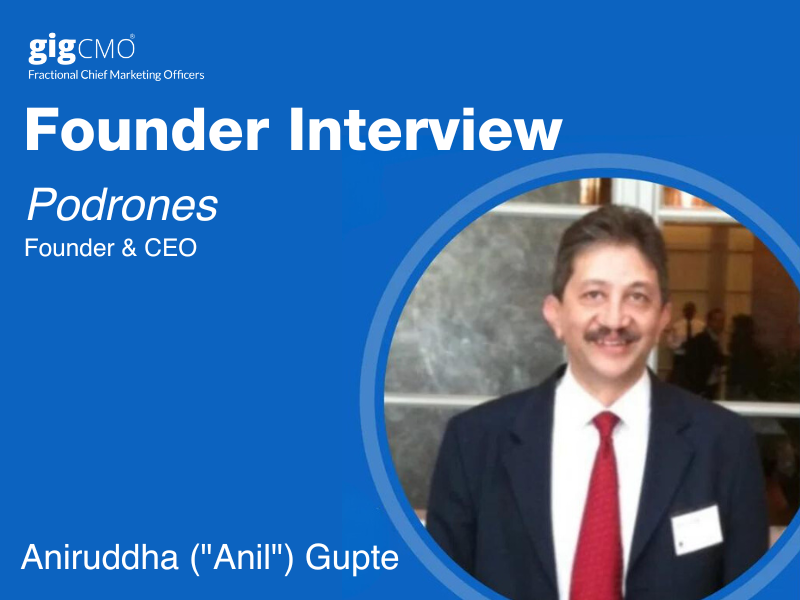
Delivering the last mile in logistics for delivery services and commerce, Podrones is an innovative technology business that has effectively created a SMART ‘Parcelbox’ system to meet the needs of fragmented last-mile shipping processes worldwide.
Podrones is the brainchild of CEO and Founder Aniruddha (Anil) Gupte, a respected entrepreneur with decades of experience growing companies, managing the development and delivery of software applications, and innovating across technological spheres.
We sat down with Anil to discuss industry innovation and the challenges of international business expansion.
What is the business model of Podrones?
In essence, it is a combination of a manufacturer model with services in an innovative business model. At the heart of it, all are physical items – Pods (electronic lockers that hold deliveries securely), PodBanks (banks of pods for multi-unit apartment buildings and offices), and Drones. However, critical partnerships with distributors are also crucial to the way it operates.
I started the company two years ago as I was looking at the e-commerce industry and realised that there is an issue when it comes to last-mile logistics. It’s an inefficient and mostly unorganized process around the world. We’re solving that problem using technology.
The company name, ‘Podrones’, refers to the ‘pods’ that we make. ‘Drone’ refers to the inevitable move to drone deliveries in the near future. To have a pod outside your door, where someone can deliver items while you’re out or busy, can solve a variety of issues and inconveniences for companies as well as individuals.
What is the value proposition?
It’s about solving a pain point in delivery services and providing convenience, security and accountability.
I experienced it on a personal note, as with two elderly grandmothers in the family, they invariably couldn’t get to the door when parcels arrived. You would then find the package left somewhere or a note saying they will try to deliver it again the next day.
While that might be a unique situation, we see the same issue with people worldwide in different ways. You don’t necessarily want mailmen and women wandering into the building in apartment buildings - especially following the pandemic. There’s a security factor in businesses, but there’s also the issue of items being delivered and forgotten if you’re in meetings or out, etc.
The pods don’t just offer security because they close and lock. They also minimise contact and send you notifications to let you know when items have arrived and reminders in case you forget to collect them.
Who is the target audience?
It’s broad - it can be individuals, apartment complexes and businesses. Geographically, we launched in Pune in India and have already expanded to Mumbai and Calcutta. We are looking to expand to the USA next. In fact, my business partner always reminds me that I tend to design for the US market first because I lived there for 20+ years.
In that respect, we modified my original design based on market research to tailor it better to consumers in India. Going into the USA, the product will be closer to the original design because it suits that market better.
What are the biggest challenges companies like yours face when expanding internationally?
Culture and understanding what motivates peoples’ buying decisions in different areas are essential. CEOs need to realise that this can lead to product amendments and differences in marketing and communications.
For example, 90% of the time, buying decisions in India are based on price. In the USA, that’s not the case. Americans are very keen to make sure they’re getting an excellent product, and they’re happy to pay for it. So for the Indian market, we modified our design to make it less expensive.
Those cultural differences also feed into the marketing and sales - even down to the terminology you use. In the US, for example, you receive Text messages, while in India, you get SMS messages. Understanding how people use different platforms also makes a big difference, e.g., in the USA, people automatically look in their emails if you send them a PIN, but in India, people will default to SMS or WhatsApp.
Local contacts and the ability to network to get leads are also big challenges of international market expansion.
What are your key learnings for other Indian companies who want to make a similar journey?
Following on from my last answer, a local perspective and physical presence can be beneficial for international market expansion.
CEOs must gain that local knowledge to understand which areas will have the right customers for their brand and understand localised pain points. For example, we found that a mailbox could be as far as a kilometre away from someone’s house in rural America. Therefore, a notification to let you know when the post has arrived could be helpful. I would say it’s best to have a representative in each new location to understand the local market, culture and preferences.
Understanding your customer is another important point. Getting to know what their buying decisions are based on is integral. We have already mentioned the different perspectives on price between the USA and India, but the customer mindset has also influenced the user interface. Our multicoloured design is inspired by Mondrian artworks and has been well received in India but may need to be modified for some customers (such as corporate buildings) in the States.
It’s really about understanding the customer and being willing to adapt to different markets.
Find Podrones here: https://www.podrones.com
If you are considering international market expansion, explore our CEO Whisperer and Fractional CMO services to get your business proposition fit for purpose.




